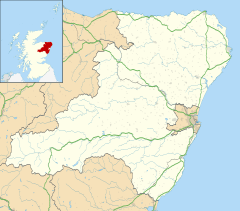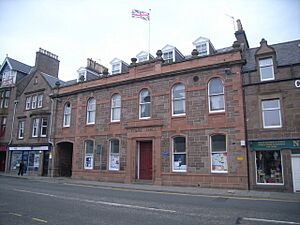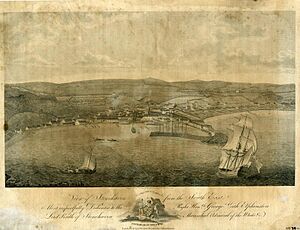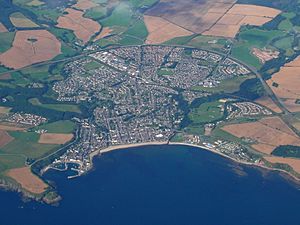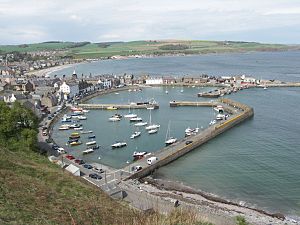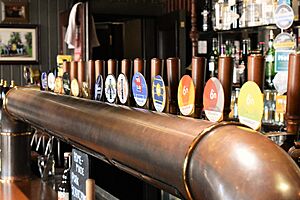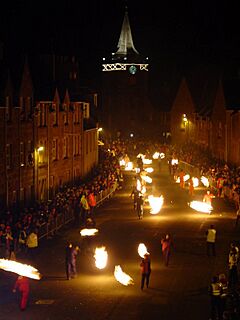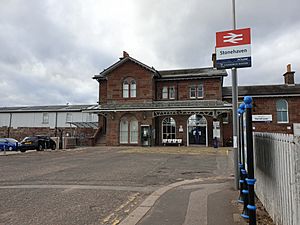Stonehaven facts for kids
Quick facts for kids Stonehaven
|
|
|---|---|
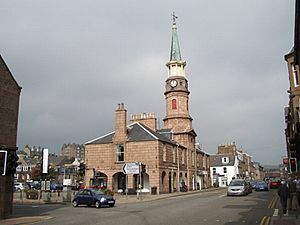 Market Square, Stonehaven |
|
| Population | 11,150 (2020) |
| OS grid reference | NO8786 |
| • Edinburgh | 79 mi (127 km) |
| • London | 386 mi (621 km) |
| Council area | |
| Lieutenancy area | |
| Country | Scotland |
| Sovereign state | United Kingdom |
| Post town | STONEHAVEN |
| Postcode district | AB39 |
| Dialling code | 01569 |
| Police | Grampian |
| Fire | Grampian |
| Ambulance | Scottish |
| EU Parliament | Scotland |
| UK Parliament |
|
| Scottish Parliament | |
Stonehaven is a town on the northeast coast of Scotland. It is about 15 miles (24 km) south of Aberdeen. In 2011, about 11,600 people lived there.
Stonehaven used to be the main town of Kincardineshire. Today, it is part of Aberdeenshire. Locals sometimes call the town Steenhive in the Doric dialect.
Contents
- Discovering Stonehaven's Ancient Past
- Stonehaven Through History
- Stonehaven's Geography and Natural Beauty
- Parks and Green Spaces in Stonehaven
- Education in Stonehaven
- Stonehaven's Commerce and Culture
- Famous People from Stonehaven
- Getting Around Stonehaven
- Public Services in Stonehaven
- Images for kids
- See also
Discovering Stonehaven's Ancient Past
Stonehaven has a very long history. People lived here even before written records began. Archaeologists have found ancient pottery and tools in areas like Spurryhillock. These finds show that people were here during the Neolithic (New Stone Age) period.
In 2004, workers found two ancient burials near Stonehaven. These burials contained burnt bones from the Early Bronze Age, around 4,000 years ago. They also found stone tools and special beads. That same year, scientists found a fossil near Stonehaven that was about 420 million years old. This fossil was the earliest known land-dwelling animal, a type of millipede called Pneumodesmus newmani.
Stonehaven Through History
Stonehaven is at the start of an old path called the Causey Mounth. This path was built on high ground in the Middle Ages. It was the only way to travel from places south of Aberdeen along the coast. This route connected the Bridge of Dee to Cowie Castle and Stonehaven's town center.
In 1639, a large army used this path during the Wars of the Three Kingdoms. Many soldiers were later held prisoner at Dunnottar Castle. A memorial to them can be seen at Dunnottar Parish Church. Other old castles nearby include Fetteresso Castle and Muchalls Castle. These castles are private and not open to visitors. The oldest building still standing in Stonehaven is the Stonehaven Tolbooth at the harbor. It was once a prison and is now a museum.
Dunnottar Castle: A Fortress of Secrets
Dunnottar Castle sits high on a rocky cliff. It was home to the Keith family. During the Scottish Wars of Independence, Scotland's most important jewels, the Honours of Scotland, were hidden there. In 1296, King Edward I of England took the castle. But in 1297, William Wallace took it back.
In 1650, Oliver Cromwell attacked the castle. He wanted to find the Scottish Crown Jewels. But just before the castle fell, some brave ladies secretly took the jewels out. They carried them by boat to a small church in the village of Kinneff. The jewels stayed hidden there for eleven years.
Stonehaven and the Jacobites
Stonehaven was a town that supported the Jacobites. These were people who wanted the old royal family back on the throne. In 1716, the Jacobite army stayed overnight in Stonehaven while retreating. In 1745, Stonehaven was still a strong Jacobite town. French ships would often bring supplies and money to its ports.
The Stonehaven Town Hall is a large building in the town used for events. It was finished in 1878.
Nearby Historic Sites
Near the Cowie Bridge to the north of Stonehaven was a fishing village called Cowie. This village is now part of Stonehaven. A bit further north are the ruins of Cowie Castle. To the west of Stonehaven is the ruined Ury House. This house once belonged to the Clan Fraser.
Stonehaven's Geography and Natural Beauty
Stonehaven is located in Stonehaven Bay, about 15 miles (24 km) south of Aberdeen. Two rivers, the Carron Water and Cowie Water, flow through the town. The town is in a deep bay surrounded by hills.
The harbor was improved in the 1820s by engineer Robert Stevenson. It became a busy center for catching herring fish in the 1800s. South of Stonehaven is Fowlsheugh, a coastal nature reserve. It has tall cliffs, 230 feet high, where many seabirds nest.
Stonehaven has grown quickly since the oil industry boomed in Aberdeen. Many new homes have been built, making the town larger. Parts of Stonehaven near the Carron Water can sometimes flood when there is heavy rain. New flood defences are being built to help with this.
An important geological line, the Highland Boundary Fault, crosses Scotland and ends just north of Stonehaven.
Parks and Green Spaces in Stonehaven
Stonehaven has several lovely parks and green areas for everyone to enjoy.
- Mineralwell Park: This is the largest park in Stonehaven. It is next to the Glenury Viaduct, a large bridge for trains. Inside the park is St Kieran's Well, an old public fountain. The park also has a large track for radio-controlled cars. In 2015, an artificial turf pitch (a sports field with fake grass) was opened here. In 2021, 120 cherry blossom trees were planted in the park. These trees honor Thomas Blake Glover, a famous Scottish businessman.
- Baird Park: This park is about four acres in size. It was given to the town in 1920 by Sir Alexander Baird, 1st Baronet.
- Stonehaven Recreation Grounds: Opened in 1885, this area is near the beach. It has tennis courts and a bowling green.
- Dunnottar Woods: This is a 32.91-hectare (81.3-acre) woodland area. It is managed by the Woodland Trust, which helps protect forests.
Education in Stonehaven
Stonehaven has one secondary school and three primary schools.
- Mackie Academy: This is the main secondary school. It teaches students from a large area of southern Aberdeenshire. Students come from places like Johnshaven in the south and Netherley in the north.
- Arduthie School: One of the primary schools, it serves the northern and eastern parts of Stonehaven.
- Dunnottar School: Founded in 1889, this school is connected to the historic Dunnottar Castle. It serves the older part of town and the surrounding countryside.
- Mill O' Forest School: This school opened in 1977 and is in the newer part of Stonehaven. It serves the southern and some northern areas of the town.
There is also a special education school called Carronhill, which opened in 1975.
Stonehaven's Commerce and Culture
In the past, fishing was the most important business in Stonehaven. The town was famous for its herring fishing. In 1894, they caught about 15 million fish! Many people worked in the fishing industry. But over time, there were fewer fish, and the industry became much smaller.
Today, Stonehaven's main businesses are marine services (helping boats and ships) and tourism. Dunnottar Castle is a big attraction, bringing many visitors each year. It has been used in movies like Hamlet and was even a background image on Microsoft Windows 7. The Disney movie Brave also used Dunnottar Castle as the home of its main character, Merida.
Near the town is the Stonehaven War Memorial. It was built after World War I and sits on a hilltop overlooking the bay. You can see it from most of the town. Stonehaven also has a long beach facing the North Sea. The beach has large cliffs and small rock pools.
The town is also known for its Olympic-size outdoor swimming pool. This pool is heated and filled with filtered seawater! The local harbor has the Stonehaven Tolbooth, which is a small museum about the town's history.
Fireball Ceremony
Every year on Hogmanay (New Year's Eve), Stonehaven has a special Fireballs ceremony. Volunteers walk down the High Street swinging large balls of burning materials. These fireballs are then thrown into the harbor. No one is sure when this tradition started, but reports show it was happening as early as 1911. Stonehaven also has a pipe band that plays at events all year.
Local Food
Stonehaven is famous for its fish and chip shops. One shop, the Haven Fish Bar, is thought to be where the deep-fried Mars Bar was first made. This sweet snack is now well-known in Scotland.
Sports and Events
Stonehaven hosts many fun events throughout the year:
- Highland Games: Every July, Stonehaven holds its own Highland Games. People compete in traditional Scottish sports like the Hammer Throw and Tossing the Caber.
- Stonehaven Folk Festival: This festival celebrates folk music. Famous comedian Billy Connolly has attended it.
- Feein' Market: On the first Saturday in June, this market recreates an old 19th-century fair where farm workers would find jobs.
- RW Thomson Classic Car Rally: This event celebrates Robert William Thomson, who invented the pneumatic tire. Many old and classic cars are displayed.
- Farmers' Market: Once a month, local farmers sell fresh fruits, vegetables, and meats in the market square.
Stonehaven also has several sports clubs. There is a rugby club, Mackie Academy Former Pupils Rugby Football Club. There are also several football (soccer) clubs, including Stonehaven F.C., AC Mill Inn, Cowie Thistle, and Stonehaven Athletic.
Local Radio
Stonehaven has its own local radio station called Mearns FM. It is run by volunteers and shares local news, events, and programs.
Famous People from Stonehaven
Stonehaven has been home to several notable people:
- Robert William Thomson: He invented the pneumatic tyre (the air-filled tire).
- James Murdoch: A journalist and expert on Eastern cultures.
- Lord Reith of Stonehaven: The very first Director-General of the BBC.
- Tom McEwen: A Canadian politician and trade union organizer.
- John Ellis: An architect who designed many buildings in Stonehaven, including the War Memorial.
- George Thomson Chapman: A New Zealand publisher.
The famous novelist Lewis Grassic Gibbon (whose real name was James Leslie Mitchell) went to school at what is now Arduthie Primary.
Important historical visitors to Stonehaven include William Wallace and Mary, Queen of Scots. The poet Robert Burns also visited friends in Stonehaven in 1787.
Getting Around Stonehaven
Stonehaven has a train station on the Dundee–Aberdeen line. It opened in 1849. The A90 road goes around the town, and it meets the A92 here. The town also has local bus services and is on the X7 Coastrider route. A fun Land Train runs from the town square to the outdoor pool, Dunnottar Castle, and the harbor.
Public Services in Stonehaven
Stonehaven has a hospital called Kincardine Community Hospital. The town also has a Leisure Centre, opened in 1985, which has sports halls and a 25-meter swimming pool. The Royal National Lifeboat Institution (RNLI) has a station in Stonehaven, providing lifeboat services to help people at sea.
Images for kids
See also
 In Spanish: Stonehaven para niños
In Spanish: Stonehaven para niños


